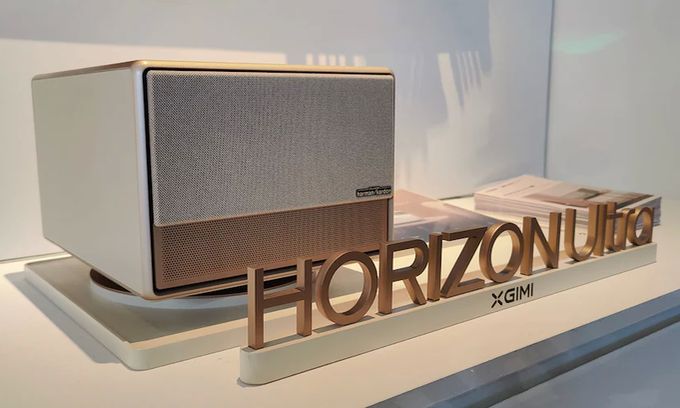XGIMI was founded in 2012 and is based in Chengdu, China. The company develops and produces high-performance multi-functional Android-based projectors and laser TVs. Today, XGIMI rightfully ranks among the industry leaders, offering projectors of almost all types. This list includes, for example, portable MoGo, Halo and Elfin, powerful Home Theater Horizon, and UST (Ultra Short Throw) Aura. Many XGIMI models occupy a place among the bestsellers and are included in most top lists.
XGIMI Horizon series is one of the most popular in the home theater segment. It was introduced in 2021 and included Horizon 1080p and the flagship Horizon Pro 4K.
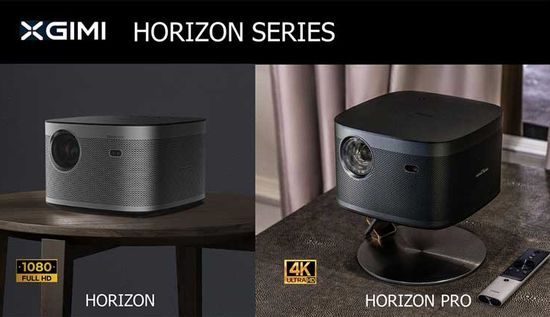
With the exception of resolution, 3D support and, accordingly, price, these mid-focal models are almost identical. They use single-chip DLP technology (0.47″ DMD chipset) and an LED light engine that provides 2,200 ANSI Lumens brightness. Both projectors produce projections up to 300″ diagonal from 0.8 m to 8.0 m with a Throw Ratio of 1.20:1. Today they cost ~$ 1,000 and $ 1,700, respectively.
XGIMI Horizon Ultra
This year, the company announced a new flagship Horizon Ultra 4K model with a hybrid laser/LED light engine. Its announced launch price is $ 1,700. Horizon Ultra also uses the popular 0.47-inch 4K DLP chipset with four-phase pixel-shifting.
As known, it supports XPR (Xpanded Pixel Resolution) technology, which ensures playback of 4K content using a relatively cheap 1080p DMD chipset. Its operation principle is simple and elegant. The projector divides the 8 million pixels of a 4K image into four parts of 2 million each. Then, using only 2 million micromirrors, it sequentially reproduces four 1080p images, shifting them by half a pixel relative to each other. Due to the high frequency, the eyes and brain perceive them as a single image with higher resolution. Pixels are shifted by tilting the lens using 4 XPR module electromagnets.
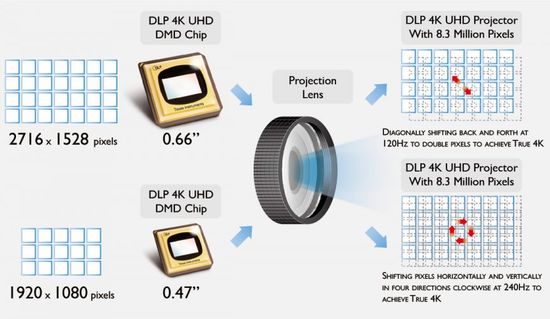
XGIMI indicates brightness of 2,300 ISO Lumens, but some sources contain 2,300 ANSI Lumens. This confusion is due to the use of the new ISO21118 standard. Strictly speaking, 1 ANSI Lumen ~ 0.8 ISO Lumens. Traditional ANSI Lumens are measured at 9 points on the screen and characterize their illumination, while ISO lumens confirm compliance with industry standards.
Moreover, some Chinese companies are starting to use CVIA (China Electronics Video Industry Association) Lumens, adding chaos to this aspect. For example, the JmGO N1 Ultra brightness is 4,000 ANSI Lumens or 2,200 CVIA Lumens. However, this situation is quite typical for world markets with fierce competition. Let’s hope the industry’s leading manufacturers can agree on conversion rates.
The flagship supports HDR10, HLG and even Dolby Vision HDR with dynamic metadata to adjust the tone mapping of encoded content in real time. This premium feature improves HDR performance when viewing streaming HDR content from web services.
Hybrid laser/LED light engine
Of course, the projector image quality depends on many specs, but brightness and color gamut are one of the main. In turn, they depend on the light source. Today their list contains several SSL (Solid State Lightsource) types of light engines, including:
– LEDs – cheap and reliable;
– laser phosphor (ALPD 3.0 – Advanced Laser Phosphor Display) – relatively inexpensive and without laser speckle;
– triple-laser RGB (ALPD 4.0 gen) – ultra wide color gamut exceeds 107% BT.2020 color space, but laser speckle is a problem.
Of course, companies are actively improving these technologies. For example, last year’s gaming BenQ X3000i used the new 4LED (RGBB) light source.
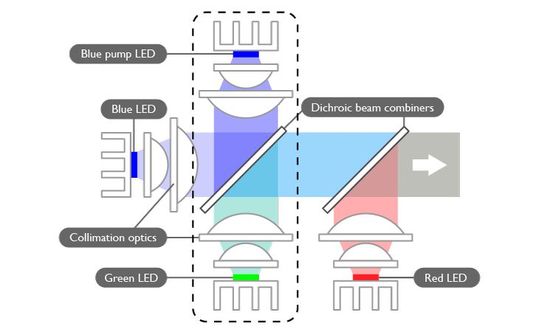
Enhanced output green increases overall brightness by 8-12%.
Traditionally for any technological evolution, its development at some stage begins to create hybrids with the pros of prototypes. New Samsung and Sony TVs with hybrid QD-OLED panels convincingly demonstrate this thesis. XGIMI also can become a pioneer in new light engines by developing the first hybrid laser/LED light source for projectors. According to XGIMI, new ‘Dual Light’ (LED + laser) light source provides high brightness and wide color gamut with accurate colors and without laser speckle.
In fact, this is RGBB 4LED light engine with additional red laser to boost the red brightness and saturation. It uses red laser, red LED, blue pump LED, green LED and a Dynamic Color Filter, which adjusts the color gamut.
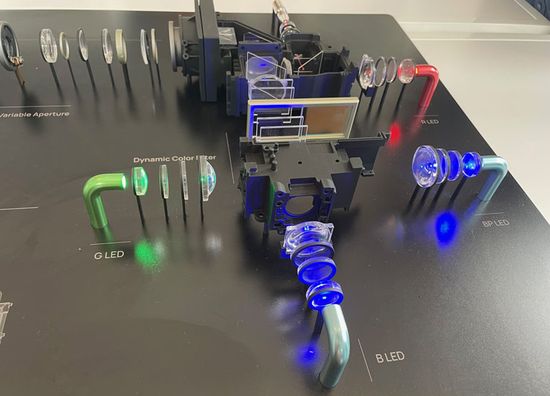
The developers announce coverage of 95.5% of the DCI-P3 color gamut, which is important for HDR content, and unprecedented color accuracy DeltaE < 1 'out of the box'. For reference, DeltaE < 3 is classified as ideal, and dE of most projectors exceeds 5 'out of the box'.
Key Features
The model has an industrial Misty Gold design with a mechanical movable grille at the front.
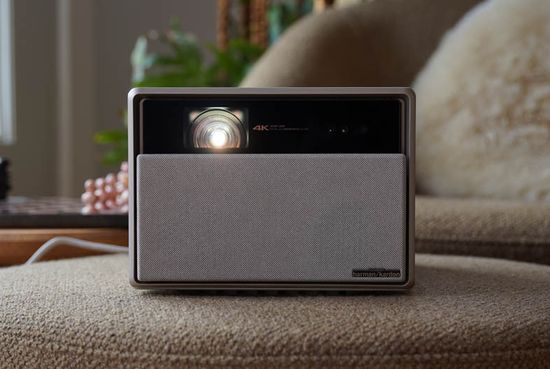
When turned on, it slides down to reveal the lens.
As known, company pays a lot of attention to improving auto-setup technologies, which maximally simplify projection settings. XGIMI’s Intelligent Screen Adaptation (ISA) technology is one of the best in the industry today.
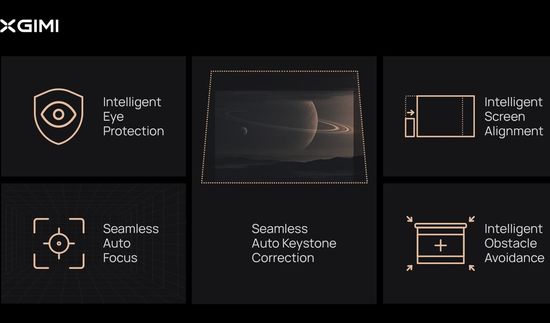
Really, continuous Auto Focus and Auto Keystone (quick image alignment without test pattern), image alignment to the screen edges, Obstacle Avoidance option (image correction in the presence of obstacles) significantly simplified the projector installation.
The new flagship uses ISA 3.0. It adjusts brightness, contrast and color for daytime or nighttime viewing, zooms in with optical zoom, adjusts keystone distortion, and adapts output for optimal viewing on colored surfaces. Improved optical and Time-Of-Flight (TOF) sensors monitor screen, providing dynamic image adjustments for different conditions. An integrated dynamic iris optimizes settings based on ambient light. For example, it increases brightness by up to 50% in diffuse daylight, and decreases it in darkness to optimize contrast and wide color gamut.
Additionally, model uses sophisticated multi-element optical zoom lens with a 1.2:1 – 1.5:1 Throw Ratio, which supports image size adjustment from 40 to 200 inches at Throw Distance of 1.3 m – 5.3 m.
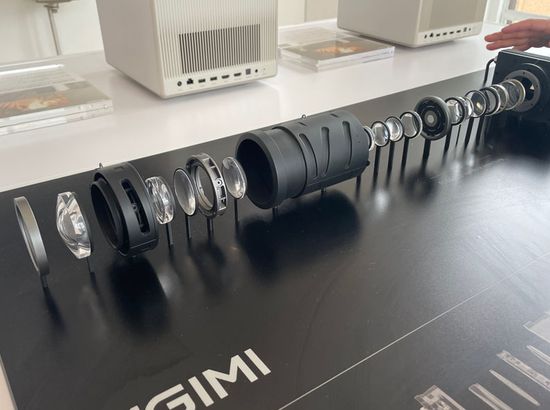
The projectots comes with a built-in Android TV 11.0 OS and streaming platform. Unfortunately, it doesn’t have a certified Netflix app, which is typical for most modern Android projectors. Horizon Ultra supports Full HD 3D, which will be an additional bonus for fans of this format. In addition, the model offers MEMC, Google Assistant and Blackboard Mode. 18-20 ms input lag for 4K@60Hz in Game mode is great for most complex games.
Picture modes and sound
The XGIMI Horizon Ultra has Movie, Football, Office, Game, and Custom image modes for SDR and HDR content. In addition, the model offers Dolby Vision Bright, Dolby Vision Dark and Custom option for Dolby Vision content.
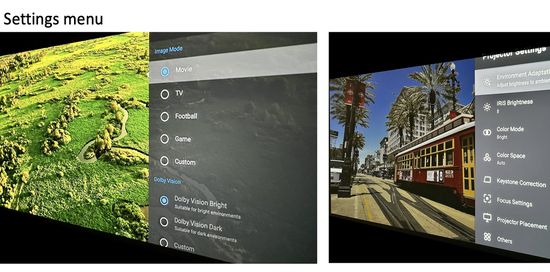
The projector automatically switches to HDR mode when it detects HDR signals at the input. Accordingly, the settings for SDR and HDR content are the same, which is not always optimal.
Movie mode provides the best image crispness. Brightness in this mode reaches almost 1,400 ANSI Lumens. Color gamut corresponds to the stated 95.5% DCI-P3.
The brightness settings include Cinema, Bright, Vivid, Performance, and Custom. With the exception of the brightest Bright, the brightness of the other modes is practically the same. Performance mode increases brightness to 1,800 ANSI Lumens, but fan noise is also significantly increased.
The Auto Environment Adaptation feature works great and is very useful when placing the projector in a living room with constantly changing ambient light levels.
The integrated Harman/Kardon sound system has a pair of 12W speakers. It supports Dolby Digital+, DTS-HD and offers various sound modes for Movies, Music, Sports, and Games. Despite its portability, the projector provides quite acceptable bass and fairly loud sound without noticeable distortion. Of course, it’s unlikely to satisfy music lovers, but non-perfectionists can easily save money on a soundbar.
Conclusion
Pros
– 95.5% DCI-P3 color gamut and DeltaE < 1 'out of the box' with innovative hybrid 'Dual Light' (LED + laser) light engine;
– 4K with Dolby Vision;
– superb ISA 3.0;
– Android TV 11;
– Harman/Kardon sound system;
-18 ms input lag for 4K@60Hz in Game mode;
– Full HD 3D.
Cons
– not ideal black levels;
– no certified Netflix app.
This year, the company introduced the portable XGMI MoGo Pro 2, which is already included in many top lists. XGIMI Horizon Ultra 4K completes the list of new products. Priced at just $1,700, it offers ultra-wide color gamut for this class and superb DeltaE < 1 'out of the box' with innovative hybrid 'Dual Light' light engine. ISA 3.0, Android TV 11, Harman/Kardon sound system, 3D support and 18 ms input lag in games complete the list of its bonuses. Considering the price and specs, Horizon Ultra has superb value for money, which guarantees it excellent marketing prospects.
To be fair, the competition’s new models are also impressive:
– Anker Nebula Cosmos 4K – $ 1,600;
– Optoma GT2100HDR – $ 1,800;
– JmGO N1 Ultra 4K – $ 2,030;
– BenQ TK860i – $ 1,700, etc.
However, healthy competition is always nice for consumers.
This video shows the new XGIMI Horizon Ultra 4K projector.
